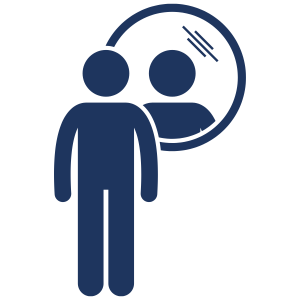
Focus Area 5: Intercultural Engagement
2. Exposing Negative Attitudes About Diversity
Diversity is not inherently a problem. The fact that we are different from one another is simply a fact, neither good nor bad. Problems arise from our attitudes about diversity, about our differences, and how our distinct differences make a difference. One person’s negative attitudes about another person’s differences can often lead to negative behaviors toward others.
PREJUDICE
Prejudice is a preconceived feeling or bias. Prejudice does not necessarily lead to discrimination, but it is almost always a factor.
Most people do have certain prejudices and biases. That’s pretty natural. Over time, we develop preferences for what we like, based on our personal experiences. If one person has a preference for a particular brand of shoe, that bias is not likely to harm another person. But when we are biased or hold a prejudice against other people just because they are different from us, that is very often a cause of harm.
Prejudice against people who are different from us comes from a belief in the superiority of one’s own race, culture, class, or another group. Some examples of prejudice include:
- Sexism (gender bias)
- Racism (racial bias)
- Ageism (age bias)
- Classism (class bias)
- Homophobia (anti-LGBTQ+ bias)
- Size
- Ability
Prejudice can be found in all people, in every ethnic group.
The challenge of rooting out your own prejudice is that it is often a conditioned response. Even people who want to avoid bias have probably been conditioned to a biased response from an early age. Further, our own biased behavior is largely unconscious. And that is a major reason most of us readily deny having biases. But denying it only perpetuates the problem. So, it’s not hard to see how prejudice and bias have become such pervasive problems all around the world.
Some prejudice may come in the form of a backlash when people perceive diversity initiatives as nothing but an attempt to take something away from their group in order to give something to another, different group of people. An example of this is equal employment laws.
Some prejudice is held in place through unquestioned conformity to prevailing cultural beliefs and customs.
Almost always, prejudice seems to fulfill an irrational drive for certain people to feel superior to other people. And very often, prejudice is tied to a person’s deepest fears, although that connection is usually subconscious, keeping the biased person unaware of the underlying fear.
Prejudice occurs in the mind – it’s a thought. Unless a person takes an action that you could positively identify as prejudiced, you’d have no sure way of knowing if that person is prejudiced.

Reflection Exercise:


STEREOTYPING
Stereotypes are fixed, inflexible notions about a group.
Stereotyping happens when we take an experience with one member of a group and apply that experience to the entire group. For example, you may have been raised to think that all members of a particular ethnic group are lazy, or cheat, or lie. Even if you personally have the opposite experience with an actual person of that ethnic group, the learned stereotype often stays in place.
Stereotypes are hard to break. Even though they are often based on misunderstanding or simply a lack of knowledge about another person’s culture, most of us simply haven’t taken the time to notice our stereotypes. It’s “just the way we think” and we don’t often challenge the way we think.
Some stereotypes are so common they may just be taken for granted as true. They may be so common that we are not even uncomfortable when we hear them:
- Men never ask for directions
- Women talk too much
- Boys are mean
- Girls aren’t good at math
Without even realizing it, our unquestioned acceptance of stereotypes can prevent us from being completely open-minded. And the stereotypes we apply to others can be hurtful to them but also to us. Seeing other people through a stereotype doesn’t allow us to get to know them for who they really are.
Rational stereotypes grow out of bits of truth and factual information and seem like just information we innocently think will help us predict how another person will behave or what could happen in some sort of situation similar to the one the stereotype grew out of. Because a rational stereotype seems to have a basis in fact, we are not likely to recognize it as bias.
Irrational stereotypes are formed without any real evidence to support them. If they’ve grown out of situations and beliefs that were emotionally charged, that emotion convinces us the stereotype is true. When we feel strongly about something, it is much harder for us to change our belief about it.
This story from a youth work professional shows how stereotypes and bias can exist at an unconscious level:
I was listening to a radio interview where the guest was describing a medical situation between doctor and patient. At first, the guest would say “The doctor did this, … and the patient said that…” and so on. But later in the interview, the guest when referring to the doctor said, “She was practicing in a very creative manner.” Instantly I was surprised. Despite knowing that there are many female doctors, I had made the assumption that the doctor was a male.
It’s a good reminder that it is a natural tendency for each of us to see the world from our own perspective and that can often result in our understanding of another person being off target. And while we may be aware of some biases we hold, we may have some biases that we are not (yet!) conscious of.
Making assumptions about an entire group of people is stereotyping, plain and simple. When assumptions and stereotypes influence our attitudes, we may find it more difficult to make a fair judgement about someone or something. This influence on judgement is called bias.
Talking about biases continues to be a difficult and tension-filled conversation in the United States as well as other countries. We are fearful of being seen as biased. As a result, we tend to deny having any personal biases or using stereotypes in our lives.
However, denying our biases does more harm than good. With denial, we lose the opportunity to learn from each other and to gain a better understanding of others.
What we need to do is respond to our biases with awareness, curiosity, and a commitment to a fuller understanding of others. With awareness, we can be open and honest with ourselves. It will allow us to be more in control so that our biases won’t drive our agendas so much.
To be effective in your work with young people, make sure that your biases do not influence how you work. This does not mean giving up your personal beliefs or values. It does mean that you are obligated to be aware, responsible, and responsive in what you say and how you behave with young people who are culturally different than you. Awareness takes effort and diligence. Multi-cultural competence is a practice as much as a state of being.

Reflection Exercise:


DISCRIMINATION
Discrimination is treating another person differently, unequally, and usually in a negative way for no reason other than the fact that they are different from you in some way.
Discrimination is often the result of our prejudices and stereotypes so undoing discrimination is not as easy as outlawing discriminatory practices and policies. We really have to dig deeper to uproot the thinking patterns and misinformed perceptions that laid the foundation for discrimination to occur. And that reinforce and perpetuate old stereotypes.
An imbalance of power is very often a factor of discrimination.

Reflection Exercise:


If you prefer to print this section of The Art & Science of Youth Work certificate course, click on the "Print Friendly" icon to select how you would like it to print. You can remove images and icons.
